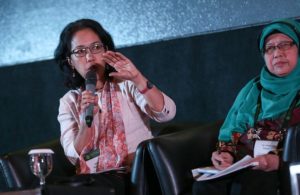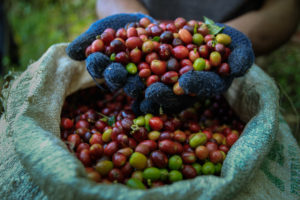
Global market demands and ecological conditions force ground-level change – and collaboration.
It’s not just the types of trees that grow in the forests – and, in some cases, the orangutans or Probiscis monkeys that live in them – or the way the rivers wind like thread through islands of wild green that make each peatland landscape unique. Each peatland ecosystem also derives its identity from the people that call it home.
Despite their oft-remote locales, these communities are directly impacted by changes in the global market. Demands for chewing gum in Japan, for instance, can change how a farmer in Central Kalimantan chooses to use his plot of land, and an uptick in natural body creams can fatten the wallets of smallholders in Sumatra.
This ever-evolving relationship between peatland communities and their means of income was the focus of the People and peat: Livelihoods in context science discussion at the Global Landscapes Forum: Peatlands Matter event on May 18 in Jakarta. Five panelists from across different sectors, including FTA researchers, sat down to share ground-level changes they’ve witnessed, and brainstorm ways communities may be able to better thrive in the future.
Read also: FTA seeks to influence debate at GLF on peatlands
ALL ABOUT RELATIONSHIPS
Due to years of exploitation, the peatland forests of Sumatra’s Tanjung Jabung Barat (more simply known as Tanjabar) district were completely degraded at the start of the millennium.
They were no longer sustainable for agriculture, and the farming communities who had long lived there were struggling. This led the Forest District Office of Tanjabar (currently known as Forest Management Unit of Tanjabar) to take action in 2009, beginning restoration efforts by planting some 500 hectares of the Bram Itam peat forest reserve using jelutung trees.

While the forest was being given a facelift, farmers began using surrounding areas to diversify their land nurseries by planting a variety of other trees for rubber, coffee, betel nuts, oil palm, coconut, galangal, ginger, and pineapple. It was better for the land and their income too.
In other villages, such as Senyerang (in northwest Tanjabar), farmers had begun domesticating jelutung trees as well, as the trees’ sap was very profitable for its use in latex and gums.
Watch:
- Finding long-term solutions for degraded peat land
- People and peat: Making a living on protected land
However, the Bram Itam peat swamp forest reserve was also prone to illegal logging, as well as migrants coming in and converting land to estate crops that sucked moisture from the ground. Again, the local government stepped in and offered a solution, allowing local farmers to harvest oil palm from previously protected, reforested areas for a period of time, so they could continue to economically sustain themselves without breaking the peace with the new influx of land dwellers.
“A profitability study conducted by the World Agroforestry Center (ICRAF) showed that the tree-based agroforestry systems on the Tanjabar peatlands provided weekly and monthly income for farmers,” said Hesti Lestari Tata, a scientist at FOERDIA, the Research, Development, and Innovation Agency within the Indonesian Ministry of Environment and Forestry.
This story can be seen as a lesson: in the same way different types of crops are needed to sustain the environment and the economy, there’s a pressing need for different groups of stakeholders to work together in order to profit from these landscapes.
“The typology of peatlands needs to be addressed from the beginning,” said Ingrid Öborn, Southeast Asia regional coordinator for ICRAF. “This takes in the complexity of peatlands – depth, maturity, and water conditions, as well as socio-economic and land governance conditions. Conflict areas and non-conflict areas need to be documented. This can be the starting point for learning and upscaling the lessons to other areas.”
This begins with open communication and negotiations between different groups of stakeholders in each area, coupled with more formal principles, such as free prior informed consent (FPIC), which holds that communities have the right to decline proposed projects that affect the land they own, use, or occupy.
“There should be a trade-off between ecological and environmental needs versus social and economic needs,” said Tata. “How can we balance the two?”
TO MARKET, TO MARKET
Along with being constantly changing social landscapes, peatlands are also constantly shifting based on what commodities the world wants and needs at any given time.

“Usually, the market is the main driver of the domestication of peatlands,” said Tata. Some local crops have long been in demand: in Sumatra’s Tanjabar district, betel nuts and Liberica coffee brought to Indonesia from Africa in the late 19th century; in Riau, sago, which is ground into starch; and everywhere, oil palm.
However, not every peatland has the right conditions to grow these crops, and communities must work within the inherent confines of their landscapes.
“Coffee and betel nuts are suitable to be planted on shallow peat that’s either hemic [partially decomposed] or sapric [decomposed],” Tata explained. “Jelutung can be domesticated almost anywhere. But the market first has to be established to secure the value chain.”
This has particularly been witnessed in regards to jelutung. In Central Kalimantan and the Jambi province of Sumatra, farmers used to enjoy a high demand and valuable price for their jelutung sap.
Read also: Agroforestry on peatlands: combining productive and protective functions as part of restoration
However, a recent plummet in the market left some communities floundering for an alternative. According to Aulia Perdana, a marketing specialist from ICRAF, only one company – PT. Sampit – is currently trying to source jelutung from Indonesia, to be sold to chewing gum manufacturers in Singapore and Japan.
As a forward-thinking marketer, Perdana is always considering what other options are available and could be profitable in the future. Right now, he says these could include rattan; decorative or ornamental fish that can be cultivated in peatland waters; bark of the gemor tree, used in incense and the increasingly-popular natural insect repellents; and the nypa palms, whose sugar-rich sap can be tapped for up to 50 years and serves as a natural buffer for the habitats of aquatic fauna.
Fisheries, too, are being increasingly incorporated in peatland areas, and the panelists agreed that a mix of fishing and agriculture is quite beneficial to the overall sustainability of the landscape – healthy land and water conditions lead to increased productivity of both. But again, this requires an intentional dialogue between different stakeholders.
“We need to get farmers and fisheries to be together responsible for managing land and water,” said Ibu Titi, who works in the South Sumatra provincial government. There needs to be a strong interaction between the two to monitor water pH levels, fish, trees, and crops all at the same time.”
“I think we need more collaboration between researchers, trade organizations, and farmers,” said Aulia. “That’s the best way forward to develop the market – growing local markets in a collaborative and participatory way.”
By Gabrielle Lipton, originally published at CIFOR’s Forests News.
This research forms part of the CGIAR Research Program on Forests, Trees and Agroforestry.











